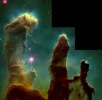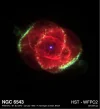You are using an out of date browser. It may not display this or other websites correctly.
You should upgrade or use an alternative browser.
You should upgrade or use an alternative browser.
In view then the thought ?
- Thread starter Rush
- Start date
Thats a great picture, Cheers Rush.
Their was a picture in a newspaper the other day that looked like a mountain range, instead it was the rifling on a bullet tip, (this is caused when the the bullet is scorched by the rifing in the barrel as the bullet is fired and travel's down the length of the barrel until leaving the gun) May be i do need to get out more

Their was a picture in a newspaper the other day that looked like a mountain range, instead it was the rifling on a bullet tip, (this is caused when the the bullet is scorched by the rifing in the barrel as the bullet is fired and travel's down the length of the barrel until leaving the gun) May be i do need to get out more

- Joined
- Mar 16, 2002
- Messages
- 6,660
- Reaction score
- 578
Yes that is a very fine image indeed!
Here is another one which sparked a lot of interest in many people since it resembles a Rose. The information and the picture is attached.
Here is another one which sparked a lot of interest in many people since it resembles a Rose. The information and the picture is attached.
This NASA Hubble Space Telescope image shows one of the most complex planetary nebulae ever seen, NGC 6543, nicknamed the "Cat's Eye Nebula." Hubble reveals surprisingly intricate structures including concentric gas shells, jets of high-speed gas and unusual shock-induced knots of gas. Estimated to be 1,000 years old, the nebula is a visual "fossil record" of the dynamics and late evolution of a dying star.
A preliminary interpretation suggests that the star might be a double-star system. The dynamical effects of two stars orbiting one another most easily explains the intricate structures, which are much more complicated than features seen in most planetary nebulae. (The two stars are too close together to be individually resolved by Hubble, and instead, appear as a single point of light at the center of the nebula.)
According to this model, a fast "stellar wind" of gas blown off the central star created the elongated shell of dense, glowing gas. This structure is embedded inside two larger lobes of gas blown off the star at an earlier phase. These lobes are "pinched" by a ring of denser gas, presumably ejected along the orbital plane of the binary companion.
The suspected companion star also might be responsible for a pair of high- speed jets of gas that lie at right angles to this equatorial ring. If the companion were pulling in material from a neighboring star, jets escaping along the companion's rotation axis could be produced.
These jets would explain several puzzling features along the periphery of the gas lobes. Like a stream of water hitting a sand pile, the jets compress gas ahead of them, creating the "curlicue" features and bright arcs near the outer edge of the lobes. The twin jets are now pointing in different directions than these features. This suggests the jets are wobbling, or precessing, and turning on and off episodically.
This color picture, taken with the Wide Field Planetary Camera-2, is a composite of three images taken at different wavelengths. (red, hydrogen-alpha; blue, neutral oxygen, 6300 angstroms; green, ionized nitrogen, 6584 angstroms). The image was taken on September 18, 1994. NGC 6543 is 3,000 light-years away in the northern constellation Draco.
The term planetary nebula is a misnomer; dying stars create these cocoons when they lose outer layers of gas. The process has nothing to do with planet formation, which is predicted to happen early in a star's life.
This material was presented at the 185th meeting of the American Astronomical Society in Tucson, AZ on January 11, 1995.
Credit: J.P. Harrington and K.J. Borkowski (University of Maryland), and NASA
Image Type: Astronomical
STScI-PRC1995-01a
Attachments
- Joined
- Mar 5, 2002
- Messages
- 20,281
- Reaction score
- 1,794
I gotta pic of my bumhole, taken with UV light, anyone wanna see?
Oh, ok, only kidding, I sozzled, ever see a moderator get moderated?
Just waiting on PM from Ian now, lol
Oh, ok, only kidding, I sozzled, ever see a moderator get moderated?

Just waiting on PM from Ian now, lol
crazylegs
Member Extraordinaire
- Joined
- Dec 31, 2004
- Messages
- 5,743
- Reaction score
- 64
I gotta pic of my bumhole, taken with UV light, anyone wanna see?
Classic flopp's.........I p***sed myself laughing when i read that...

Rush
Cool Cruncher
- Joined
- Nov 3, 2005
- Messages
- 4,129
- Reaction score
- 9
If we turn our sights closer to home though , within our solar system ..it really does amaze me how Mars from once an abundant world of life has become desolute !! . My theory is this happened a few million years ago , maybe their evolution was interupted by a comet or an asteroid that destroyed their equivalent of dinosaurs ?.
We as intelligent humans have occupied this planet for a couple of thousand years and seeing as our sun is half way through its life of 5 Billion years you have to ask yourself 1 question ...we are so lucky to be here ??. Life could have existed and been abundant on mars for millions of years ...it could have only taken 1 catastrophic cataclysmic explosion to reduce that to red ash in seconds ??..the red ash that we all associate it with Today !
Just a thought
We as intelligent humans have occupied this planet for a couple of thousand years and seeing as our sun is half way through its life of 5 Billion years you have to ask yourself 1 question ...we are so lucky to be here ??. Life could have existed and been abundant on mars for millions of years ...it could have only taken 1 catastrophic cataclysmic explosion to reduce that to red ash in seconds ??..the red ash that we all associate it with Today !
Just a thought

Ask a Question
Want to reply to this thread or ask your own question?
You'll need to choose a username for the site, which only take a couple of moments. After that, you can post your question and our members will help you out.


